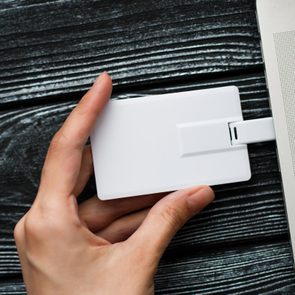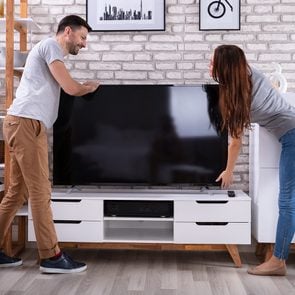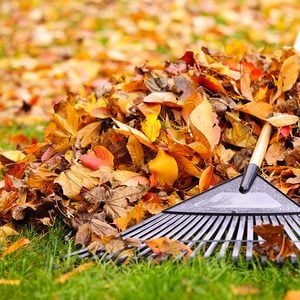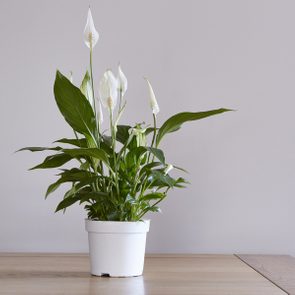Concerned about your privacy when texting or making phone calls? Signal is a popular secure private messaging app that everyone from Twitter founder Jack Dorsey to whistleblower Edward Snowden use, according to the app’s website. It has also gained popularity during the recent pandemic and during protests as a way to communicate safely. Even WhatsApp uses Signal’s open-source safety protocols for its own app.
Thinking about using it for yourself? Here’s everything you need to know about Signal, from how to use it, to the details on just how safe it is to use.
What is Signal?
Signal private messenger
Signal is a free private messaging app that you can use to:
- send text messages
- send photos
- send voice messages
- make calls
- make video calls
One of the biggest reasons Signals is so popular is that it uses end-to-end encryption that prevents others, including the government, from accessing and monitoring messages. Also, messages are stored locally, on your device, not in the cloud. This means that the company isn’t storing—and potentially sharing—your private messages. Signal also doesn’t access your private data, share your information in the cloud, or accept advertising. We’ll talk more about Signal’s safety features later. (Before selling or recycling your old phone, read up on how to delete everything on your iPhone.)
Signal for iOS and Android
Signal is available for both iOS and Android and also available to download on your PC or Mac. You can download Signal directly from the Signal download page, the Apple Store if you have an iPhone, or Google Play if you have an Android.
How Signal works
Signal encryption
Both calls and messages sent through the Signal app have end-to-end encryption. What this means is that your message is encrypted in the app before it is sent out to your network and the internet. It remains encrypted until it reaches the recipient, where it is decrypted inside of the recipient’s app. “This provides a higher level of security than previous generations of messaging apps, that only provided encryption in the form of HTTPS,” explained Cody Beers, technical training manager at WhiteHat Security. No one, not even Signal, can see your messages except for the person you send the message to.
It’s important to note, however, that this encryption only works if the person you’re sending the message to also uses Signal if they use an Android device. (On Apple devices, all messages are encrypted, no matter if the recipient is using Signal or not.) You’ll know if you see a locked icon next to the send button after you enter the recipient’s phone number. (Here’s how to tell if your phone has been hacked.)
Signal features
Signal has everything you want in a good messaging app, including:
- Group chats. Group chats on Signal can have up to 150 participants. For comparison’s sake, iPhones can have a max of 25 participants, depending on your carrier that number may be as low as ten.
- View-once Media. You can choose to have a photo or video disappear after the recipient(s) see it. Unlike other apps, Signal prevents the recipient from taking a screenshot of your image. It’s still possible, of course, that someone may take a photo of the message using a different phone or camera, so you still need to think twice before sending anything truly private.
- Photo editing. Some editing features within the app include adding text, drawing, face blurring (helpful if you want to conceal someone’s identity in a photo), and stickers.
- Additional media and information. You can add emojis, GIFs, contact information, voice messages, or your location to any message
- Note to Self. Instead of choosing a person from the contacts list, you can choose “Note to Self,” which essentially sends messages to yourself. The note will be sent to all of your devices that are linked to your Signal account.
Is Signal safe?
Signal prides itself on keeping you and your information safe in several different ways. For one, “Signal is also an open-source app, meaning the code can be reviewed by anyone to make sure there are no flaws in the app and its system,” says Chris Hauk, consumer privacy champion at Pixel Privacy.
Additionally, Signal says that it does not “collect or store any sensitive information. “Signal messages and calls cannot be accessed by us or other third parties because they are always end-to-end encrypted, private, and secure.” Another plus is that it doesn’t accept advertisements, so it “doesn’t share your info with advertisers or any other Nosy Nellies,” adds Hauk.
A measure you can take to keep it as safe as possible is to lock the app so that it can only be opened by your phone’s screen lock password or fingerprint. You can even prevent your phone’s keyboard from using its AI learning features when you have the app open by changing your privacy settings. (Here’s how to clear cookies from your phone.)
Can Signal be tracked?
Signal not only encrypts messages, but it also hides virtually all metadata associated with the message, including who sent the message, Hauk explains. “That means only the person who sent the message or received the message knows who the sender is,” he says.
Even with all of these security features, just like with other apps, it isn’t 100 percent secure. While Signal makes it harder for hackers, the app can potentially be hacked through spyware apps. These apps can log keystrokes and take screenshots of other apps, making it possible for a hacker to monitor a Signal conversation.
Can Signal messages be retrieved?
“Signal does not store messages, conversation histories, or encryption keys in the cloud, the messages are stored only on the user’s device in an encrypted format,” says Hauk. Since messages and calls are stored locally on your device instead of the cloud, Signal has no way to retrieve your messages if your phone is lost or stolen, nor can they turn them over to law enforcement.
Next, check out 40 iPhone tricks that will make things so much easier.
The subject heading on the email was surprisingly mundane: “Final pre-op appointment letter.” It sat in my inbox for hours before I finally opened it, believing it was just another pre-screening for the kidney transplant I desperately needed. There was a list of appointments and test dates, and at the bottom—almost as an afterthought—it said: “Your kidney transplant surgery has been scheduled for Thursday, June 13, 2019.”
I stopped cold. I had to reread that line several times before I could start to grasp what it really meant: my cousin Christine really was going to risk her life in order to save mine.
Back in January 2018, at age 37, I had started feeling exhausted and extremely itchy and cold all the time. I chalked it up to dry, winter skin and working too hard. Another two months passed before I tested my blood pressure at the grocery store, and the shockingly high reading prompted me to make a doctor’s appointment.
My GP ran a few tests, and I continued on with my life. I’m a television reporter at CityNews Toronto, and I was in a car heading to an interview when I got the call: my kidneys were failing. On my doctor’s advice, I hightailed it to the nearest emergency room, and was admitted.
There I was, decked out in a hospital gown with camera-ready hair and makeup. I couldn’t believe what was happening—even though kidney disease runs in my family. My father had spent four years on dialysis before receiving a transplant; he passed away at 50 from a complication of the disease. I knew that I had inherited a rare kidney condition, Alport syndrome, from my dad, but I had been regularly monitored until I was 18, and my doctors didn’t think it would be an issue. Most women who have it are carriers but don’t have symptoms. I was supposed to be in the clear.
My mother immediately started the process for becoming a living donor. But she had to lose 50 pounds before her application would be considered. While she got on the treadmill, my kidney specialist and his team tried to help me stave off complete organ failure. He was frank about my situation, but optimistic. He told me I would need dialysis and that with end-stage kidney failure I was essentially sterile and unlikely to be able to have children until I received a transplant. And if I didn’t get a transplant, I would eventually die.
Many doctors would have rolled me straight to surgery to install the dialysis equipment, but he thought I might be able to avoid it with the right combination of vitamins, prescription drugs and dietary changes—and if I didn’t have to wait too long for a transplant.
After three days, I was released from the hospital but returned for countless blood tests and appointments. I also had to go through a transplant workup: ultrasounds, cardiovascular tests and even vascular tests to see if I was able to undergo hemodialysis (having blood removed and cleaned through a machine, then pumped back in).
My diet changed dramatically, too; no more Diet Cokes, no more pickles and no more cheese, because my body couldn’t filter out all the phosphorus and sodium. I had to limit my liquid intake to less than 1.5 litres a day and chewed gum to quench my thirst. I had to take a battery of pills—vitamins, minerals and prescription drugs—and get weekly shots to keep my hemoglobin levels high.
After five months, my kidney function dropped further, and my symptoms got worse. I had restless-leg syndrome and could barely sleep; I was so exhausted that some days I couldn’t get out of bed. Seemingly easy tasks, like putting away laundry, became monumental. Though the process to determine if my mother could be a donor was still under way, I couldn’t wait much longer. In August 2018, a catheter was inserted into my stomach. By September, I was doing peritoneal dialysis every night at home in order to do the work my kidneys usually do. For nine to 10 hours at a time, I became a prisoner to my dialysis machine.
During this time, my mother lost the weight, but due to the reduced kidney function that comes with age, she was ultimately deemed an unsuitable candidate. I was put on the wait-list for a deceased donor, but I was advised that, given my blood type, I wasn’t likely to be called for seven years—if I could survive that long.
And then Christine stepped up.
My extended family is fairly close, but I didn’t spend much time with my cousin Christine Hodgkinson when we were kids. She’s 17 years older than me, so she wasn’t a playmate; she was someone I looked up to. I remember being eight or nine and asking her if I would get her high cheekbones and beautiful eyes when I grew up. Little did I know that I would end up getting something else instead.
Christine, a mother of five in her mid-50s, had already gone through the process to be a living donor when her father-in-law needed a transplant several years before. She was a match, but a blood relative was ultimately a better option. Now here she was willing to go through it all again.
Familial organ donations are often best, and recipients of organs from a live donor typically have better outcomes. Transplant coordinators will only look at one candidate at a time, so once my mother was off the list, my sister—who isn’t eligible to donate because she shares the same genetic variant as me—immediately called Christine, who had offered to be tested when I was first diagnosed.
I didn’t want to put Christine in a difficult position by reaching out to her directly. It’s not exactly an easy ask. You aren’t borrowing a dress or even a couple thousand dollars—you are asking somebody to undergo major surgery. The procedure for a living donor can be longer and riskier than that of the recipient. Kidneys are protected by a variety of other organs, which means there’s a chance that those organs and their surrounding tissue could be injured during the removal process. Even if the transplant was a success, she would still assume the potential for future high blood pressure or kidney problems, among other issues—all so I wouldn’t have to be tied up to a dialysis machine every night.
Despite the sacrifices, Christine told my sister she would do it. After she completed the initial tests, it took five months to confirm that she was a suitable match. Although she was busy helping to care for her seriously ill father, Christine regularly made the 90-minute drive from her Keswick, Ont., home to downtown Toronto for testing. Sometimes the tests were scheduled so early that she’d leave home before dawn or stay in a hotel the night before.
Christine and I had our final pre-op appointments on the same day, and that’s when the reality of what we were doing sunk in. I was petrified about what could happen to Christine and to me. What if the transplant didn’t work?
Two days later, I called Christine to see if she would be okay with postponing the surgery for a few weeks. I felt like I needed more time to process what was happening. She talked me off the ledge, reassuring me that she knew the risks and was willing to take them. Then we joked about how horrible our hair would look after spending days in the hospital. By the end of our call, I felt reassured that Christine truly wanted to do this—and so did I.
Christine and I didn’t get to see each other on the morning of the transplant. She went into surgery hours before me, while I was surrounded by family in the waiting area. Surgeons removed her kidney, staff cleaned the operating room and then the team transplanted her kidney into my body—close to my groin, attached to the femoral artery, leaving my non-functioning kidneys in place because removing them could harm my other organs.
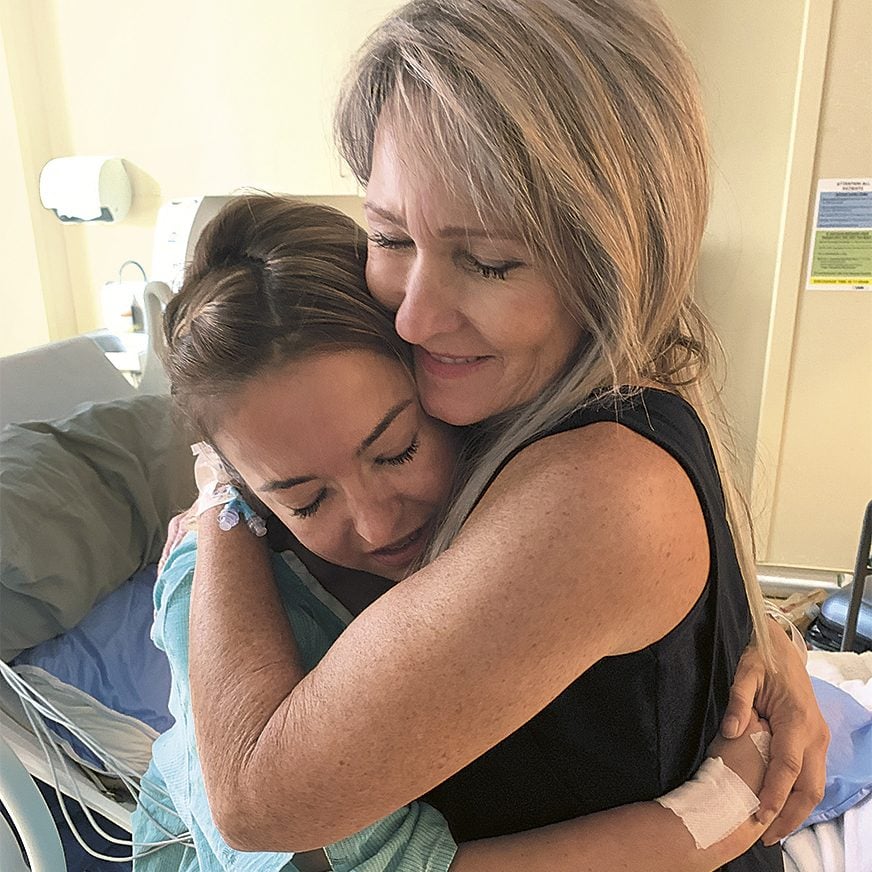
Hours after the surgery, I woke up to cheers from the street: the Toronto Raptors had just won their first NBA championship. Those hoots and hollers weren’t for Christine or me, but they may as well have been. For the first night in 10 months, I wasn’t plugged into a dialysis machine.
I spent the next few days in a drug-induced haze in the equivalent of a transplant-only ICU, while Christine recovered on another floor. When we finally saw each other in my room, the newly formed bond between us was remarkable. I felt completely linked to her, like we were sisters. She would never again be a cousin who I only saw at holidays and weddings. I had a girlfriend visiting at the time, and Christine put her phone in camera mode, handed it over to my friend and then gave me a giant hug. That photo, which is displayed in my home office, is now an iconic one in our family.
Christine was discharged a few days later and spent the summer recovering with seemingly no setbacks. My recovery was more gradual, but I felt the impact of her kidney almost immediately. After I sobered up from the pain meds, I felt years younger. I didn’t have to drag myself out of bed or deal with hours of dialysis every night—and I could last an entire day without needing a nap.
Although I’m on the other side of my surgery now, I will always have kidney disease. I need to take certain medications for the rest of my life; the immunosuppressants I’m on—to ensure my body doesn’t reject the new kidney—make me vulnerable to disease and viral infection. They also have radically increased my risk of skin cancer, so I can’t go outside without lathering up in sunblock. I go for blood work every week, and if my levels of creatinine (a toxic waste product) are too high, I’ll be readmitted to hospital.
That’s what happened on Labour Day weekend in 2019. I was ready to go away with my partner on our first overnight trip in years where we didn’t have to bring a 50-pound dialysis machine and enough supplies to be mistaken for exhibitors at a medical trade show. We were about to leave the house when I got the call.
My creatinine levels were rising: they were more than double those of a healthy person, and my nephrologist wanted to admit me to the hospital. He was concerned that my body was rejecting Christine’s kidney. When I got off the phone, I sat on the floor of my bedroom, next to my suitcase, and sobbed—about the potential loss of the kidney, what that would mean for my gradual return to normalcy and also the horrible possibility that all of Christine’s heroic efforts might have been in vain.
I told just a handful of people that I was back in the hospital; I decided only to let Christine know if things escalated. My doctors weren’t sure what caused the spike, but after two days on an IV, my creatinine levels started returning to normal.
I was waiting to be discharged when Christine sent me a text. “Hey there. How are you feeling? Hope everything is still going well.” We hadn’t spoken in about a week. I told her about the false alarm. She’d later tell me that she felt something was wrong all weekend.
A few weeks after my scare, Christine told me that her single kidney had grown (which is common for solo kidneys as they pick up a bigger workload) and she now had 70 per cent functionality. That was the first night in months where I slept soundly. We were both going to be all right.
I returned to work in October 2019 and feel even more invigorated than before my diagnosis. I’m able to fully enjoy life, whether it’s going to my annual girls’ Christmas party without falling asleep on the couch or taking long walks with my partner.
A year ago, I was tied to a machine every night, dreaming of better days. Now they’re here.
© 2020, Cristina Howorun. From “My Cousin Gave Me Her Kidney and Saved My Life,” Chatelaine (January 9, 2020), chatelaine.com.
Check out more acts of kindness that will warm your heart.
Windows hotkeys—when you press two or more keys at once to tell your computer to do something specific—are your, well, key to saving time when you’re at your computer. Once you have them memorized, you’ll find that this process is faster than using your mouse to go into a menu and select a command.
Microsoft Windows has certain keyboard shortcuts that can make switching between applications, taking screenshots, opening certain programs, and more, faster using hotkeys. Here are the ones you need to know.
Basic PC keyboard shortcuts
These basic Window commands will work on all applications, browsers, and programs, as well as Windows 10 and earlier versions including Windows 8.
Note: To make any hotkey work, you need to press the indicated keys at the same time.
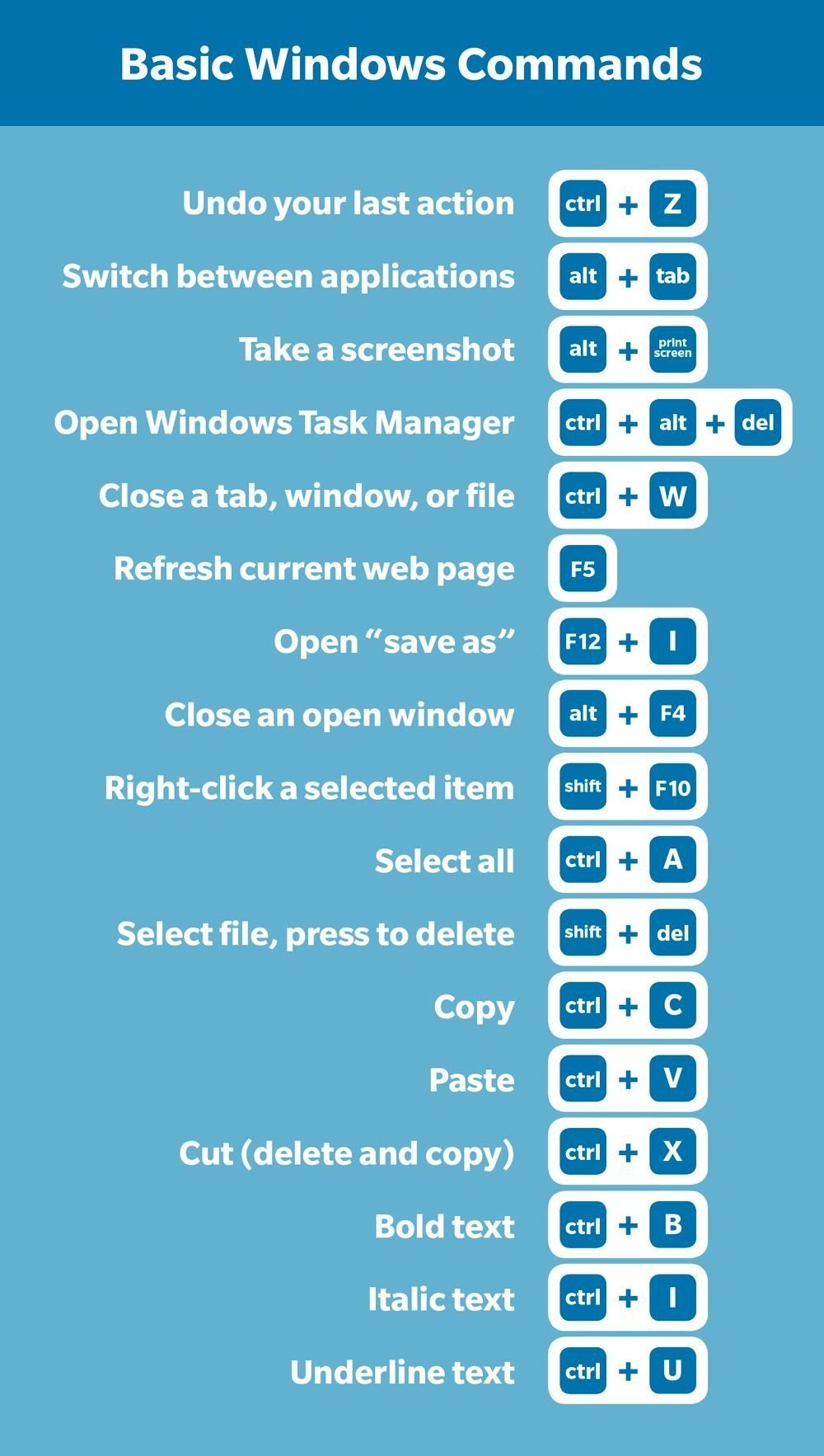
-
CTRL + Z: undo your last action, such as typing the wrong word or accidentally deleting a file. This doesn’t work to reopen closed windows, though.
-
Alt + Tab: switch between your open applications.
-
Alt + Print Screen: take a screenshot
-
CTRL + Alt + Delete (Del): open the Windows Task Manager application.
-
CTRL + W: close a browser tab, window, or open file.
-
F5: instantly refresh the current page in your browser.
-
F12: open the Save As… window when you’re in a word processor application like Microsoft Word. Here’s a list of what all the computer F keys do.
-
Alt + F4: close an open window.
-
Shift + F10: right-click on a selected item.
-
CTRL + A: Select all
-
Shift + Delete: select the file, then press to delete.
-
CTRL + C: copy something you have selected on your screen
-
CTRL + V: paste the selection you copied.
-
CTRL + X: cut (delete and copy) a selection.
-
CTRL + B: start typing in bold. Hit the hotkey again for regular text.
-
CTRL + I: start typing in italics. Hit again for regular text.
-
CTRL + U: Start typing words that are underlined. Hit again for regular text.
Navigating Windows shortcuts
Many Windows keyboard shortcuts involve tapping the Windows key. What is the Windows key? It is a key specific to PC computer keyboards (basically the PC version of Apple’s command key) and can be identified by the Windows logo. It is typically found next to the Alt key.
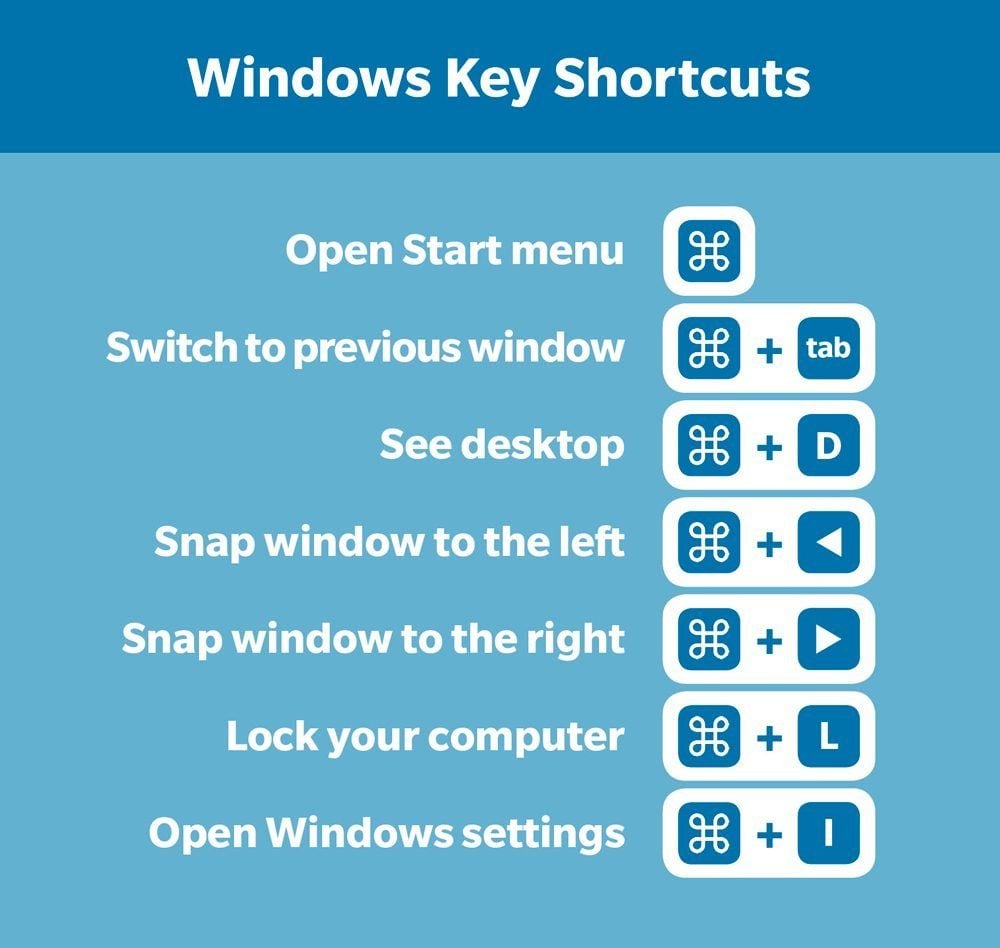
Here are some Windows key commands and what they do:
-
Windows key (Win): opens the Start menu on your computer.
-
Windows button + Tab: switch your view from one open window to the next. For example, you can go from your browser to Photoshop and back simply by tapping this combination of hotkeys.
-
Windows key + D: make the desktop pop up on the screen.
-
Windows key + left arrow key: To organize two windows that you want to look at side-by-side, open one window and tap this hotkey to “snap” the second window to the left side of the screen. Then, open the other window and tap the Windows key + right arrow to snap the second window to the right. This works on Windows 7 and up.
-
Window key + L: Lock your computer quickly.
-
Windows key + I: open your Windows settings application.
Next, find out 10 tricks to make your computer run faster.
Alberta’s majestic Rocky Mountains are world-renowned for their hiking and skiing. Although I used to ski in Quebec when we lived there, after our family moved to Alberta in 2001, the definition of skiing took on an entirely new meaning.
On a brisk Saturday morning, after a two-and-a-half hour drive, we arrived at Sunshine Village Resort for the first time since coming to Alberta. Stepping out of our van, I practically needed an oxygen tank to replace the air being knocked out of me as I glimpsed the magnificence of the mountains towering above me.
My oldest brother Justin nudged me out of my stupor, asking, “Are you finally going to try snowboarding?”
“Not a chance,” I replied.
Throughout the day, as I “shredded powder,” I began to regret my response. I became envious of how much more cool and fun snowboarding seemed. However, fear of breaking a bone, making a fool of myself, or the time it might take to learn the sport, held me back at the time.
Eventually, skiing lost its appeal and, a year later, I felt compelled to face my fear of snowboarding. I had tried it once back in Quebec, albeit with multiple face plants, but I was encouraged to take another crack at it. So, on a trip to Lake Louise the following winter, I stared down my fear of failure and rented a board.
As soon as I strapped my right foot into the binding, confidence began to build in me. I stood up and started sliding forward, but lost my poise and my balance, and stumbled into a pile of wet snow. I picked up both my board and myself and walked over to the bunny hill while witnesses struggled to suppress their laughter as I passed by. I gathered what little confidence I had left and found a way to conquer the bunny slope.
Soon after, I was ready to join the pros. Waddling to the front of the chairlift line, I was paired with three strangers and endured an awkward silence riding up as the chair swayed back and forth in the frigid wind. Approaching the top, the lift did not slow down, the toe edge of my board caught the snow, and like Humpty Dumpty, I rolled down the landing pad, nearly taking the other three passengers with me.
Near the end of the day, I pulled my face out of the snow with a “pop” after a particularly violent fall and the world spun about me for a moment until I regained my sense of gravity. Then, shaking the snow from my toque and goggles, I stopped and stared in awe at the poetic beauty in front of me: clouds floating past and mingling with the Rocky Mountain peaks; the pines that mysteriously grow straight in spite of the severe slant of the mountain; and the falling snow gracefully nesting on the tree branches.
In that moment of awe at the Lake Louise landscape, I had an epiphany. Despite enduring falls, others’ laughter, and the danger of plastering myself into a tree, I remained determined to get satisfaction from riding one of Canada’s greatest mountains. With a new outlook, I continued tumbling down the mountain.
Looking back, all the trouble of learning how to snowboard has taught me to not only appreciate the process of learning, but to also appreciate our stunning Canadian surroundings. Yes, I may have put myself at risk from jagged rocks protruding from the snow or collisions with fellow skiers, but somehow, I came out alive with a renewed admiration of my country and province. By having the opportunity to enjoy Lake Louise and the Canadian Rockies, I’ve learned to be more grateful for a place more people should try to experience.
Next, check out seven essential things to do in Banff on your next trip.
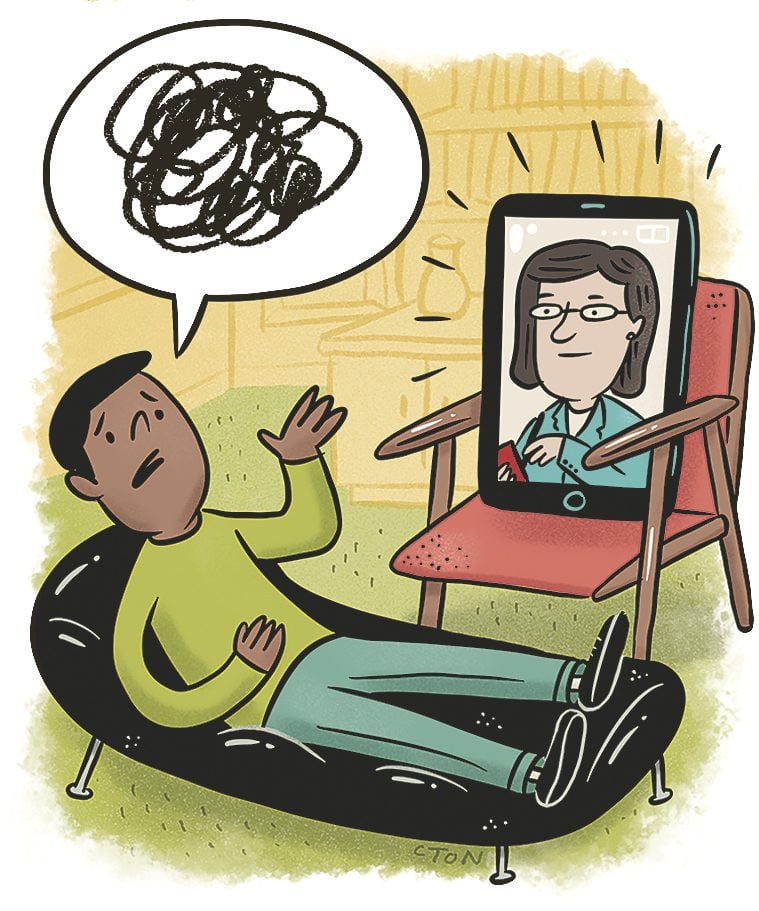
The Truth About Talk Therapy
1. Therapy is for anyone, any time. “Therapy can enrich your life by making you understand why you repeat certain patterns,” says Carrie Foster, a Montreal psychotherapist. “You don’t need to be in crisis, though that’s when most people come in.”
2. As the pandemic has pushed therapy online, studies have shown patients are just as satisfied with a video call instead of an in-office visit.
3. Try to make sure you’re visible during a video call, and that you’re in a private space with no disruptions. “Your body language, facial expressions and voice intonation give your therapist important clues about where you’re at,” says Foster.
4. Therapy costs vary greatly depending on region and type of service, but range between $30 and $240 an hour. For the 60 per cent of Canadians with private health insurance, plans may cover some or all of the cost up to an annual maximum. “Many counsellors offer sliding scale fees based on your income,” says Victoria therapist Richard Routledge.
5. Persistent stigma prevents many from seeking the help they need. A 2016 survey by the Centre for Addiction and Mental Health found that among respondents who had experienced anxiety or depression, 40 per cent were too ashamed to seek medical help.
6. There are over 50 types of psychotherapy. One of the most common, cognitive behavioural therapy, is often recommended for mild to moderate anxiety and depression.
7. Other common types of therapy include coaching, which motivates you toward a specific, performance-oriented goal, and psychodynamic therapy, in which you talk about your past, your dreams and your fantasies to uncover the thought patterns that guide your behaviour.
8. The best way to find a therapist is through word of mouth—ask for a recommendation from a friend or your doctor. “Many counsellors offer a free brief consultation over the phone so that you can get a feel for their approach,” says Foster.
9. Digital therapy platforms like BetterHelp, a smartphone app that connects you to licensed therapists via text messaging and video calls, saw new sign-ups double in the first few months of the pandemic, compared to the year before.
10. It can take several tries to find the right therapist—don’t be discouraged if you don’t jibe with the first one you meet. “You can simply say that it’s not a good fit,” says Foster.
11. Don’t expect your therapist to tell you what to do about a problem. “It’s not our place,” says Routledge. “Therapy is about tapping into a person’s own self-knowledge so that you can make your own decisions.”
12. There’s no need to apologize if you don’t have a specific therapy goal. “Our job as counsellors is to put all those pieces together,” says Routledge. “As long as therapy is useful for you, that’s why we’re here.”
13. If you need immediate support, text WELLNESS to 741741 to access Wellness Together Canada’s free, confidential mental health resources and counselling services, funded by the government as a response to the pandemic. Find out more at ca.portal.gs.
Next, discover how one Toronto storefront provides accessible and affordable therapy.
Seeing sticky stuff on your houseplants? This is a sure sign that your indoor plants have bugs. Here’s how to protect your plants and treat the most common indoor plant bug problems.
Mites, Aphids and Scale on Indoor Plants
Pests such as mites, aphids, scale and mealy bugs drink up plant juices, secreting the excess. This clear sticky substance is called honeydew and is often the first clue these pests are feeding on your plants. The leaves may also yellow and turn brown.
Try rinsing the bugs off indoor plants first. A strong blast of water dislodges many of the insects. If that doesn’t get rid of them, move on to insecticidal soap or organic horticulture oil labeled for houseplants. (Don’t miss the low-light houseplants that thrive in near darkness.)
Fungus Gnats, or Small Flies, on Indoor Plants
Question: I received a plant as a gift, and along with it came gnats! Insecticidal soap didn’t work. Watering less seems to help, but as soon as I water, the gnats are back. Do you have any pointers? —Peggy Haskin of Racine, Wisconsin
Are small flies flying around your indoor plants? Fungus gnats are those annoying insects that look like small fruit flies flitting around the house. Controlling immature fungus gnats, which are wormlike larvae that feed on organic matter in the soil, eliminates the problem. Fungus gnats are not harmful but certainly are annoying. To evict them, allow the soil to go a bit drier and trap the adults with a container of apple cider vinegar on the countertop. And there is another organic option. Bacillus thuringiensis israliensis (Bti) is a naturally occurring bacterium that kills the fungus gnat larvae, mosquitos and black flies. Just sprinkle the bits on the soil surface and water. When the fungus gnat larvae feed upon the Bti, they die. Best of all, the product is safe for pets, people, and wildlife. Sprinkle the product over the soil surface and repeat as often as the label directions recommend.
Next, check out how to revive a dead plant.
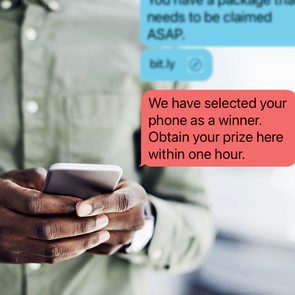
 What Is Smishing?" width="295" height="295" />
What Is Smishing?" width="295" height="295" />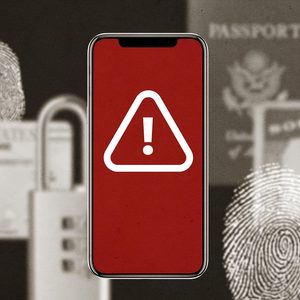

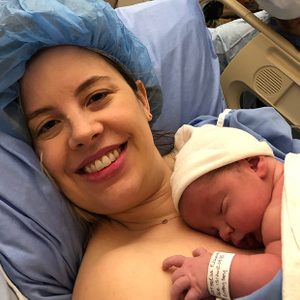 I Had a Baby During the Lockdown" width="295" height="295" />
I Had a Baby During the Lockdown" width="295" height="295" />
